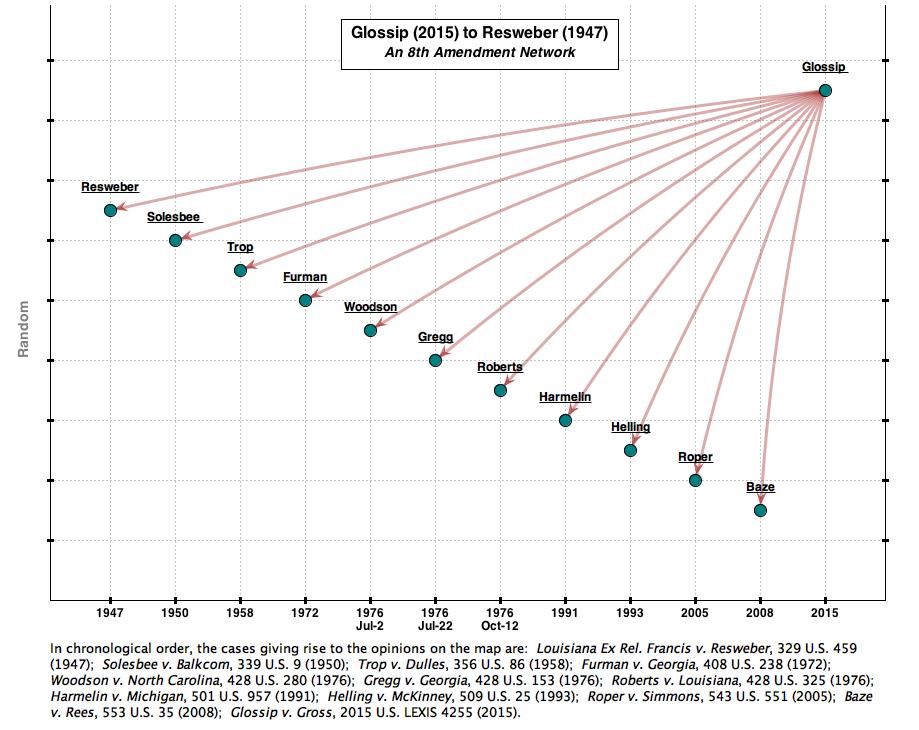On the last day of last Term (June 29), the Supreme Court handed down Glossip v. Gross, which effectively authorized under the Eighth Amendment lethal injections that use a three-drug protocol of midazolam, pancuronium bromide, and potassium chloride. Since then, the case for Richard Glossip’s innocence — or at least the weakness of the case against him — has received widespread attention. Glossip nonetheless came within minutes of execution on September 30; Oklahoma Governor Mary Fallin only issued a stay due to problems with the lethal injection cocktail. Now an inquiry is underway and no executions will occur in Oklahoma until Spring 2016 at the earliest.
To be clear, Glossip’s current reprieve did not arise from official concern over his guilt. The issue is technically about drug acquisition. Yet the death penalty’s problems run deeper than drugs. In Glossip’s particular case, vital innocence questions remain and Glossip’s supporters will raise these questions in whatever forum they can. More generally, serious Eighth Amendment issues loom over administration of the death penalty. It’s no accident that SCOTUS’s Glossip decision was a 5-4. Capital punishment is hanging on by a thread.
For those interested in learning more about the history of the Eighth Amendment debate, I offer today three looks at doctrinal territory at issue in Glossip. Each map is different way of visualizing the citation network connecting Glossip to a 1947 case called Francis v. Resweber, which upheld the constitutionality of electrocuting a prisoner a second time after a botched first electrocution attempt. Glossip cited Resweber and it cited 10 cases that in turn cited Resweber. Unsurprisingly, almost all the cases in this 2-degree network concern the Eighth Amendment.
This first map shows the basic network and was created by querying CourtListener’s API to find all the cases cited by Glossip that themselves cited Resweber. Note that CourtListener does not yet distinguish between majority and separate opinions (though that is coming soon!) and so the connections between Glossip and Resweber could occur via dissenting cites. Note further that the Y-axis in the map above has no significance. Cases are arranged for maximum visual impact.
This second map is pretty much the same thing as the first, except that the spaces on the X-axis are proportional to the actual time between cases. (In the first map, the space between cases was the same no matter what). I also changed the colors, just for fun. As with the first image, clicking the second image opens a full-sized and more readable version of the map. The first map links to cases in CourtListener, while this second map links to cases in Casetext.
The third map once again shows the same network, but this visualization uses a Spaeth Projection. This means that Y-axis now has meaning: it shows the vote for outcome and whether this outcome was “liberal” or “conservative” according to the Supreme Court Database. Note that Glossip is coded as a 5-4 conservative decision as is Resweber. To see the SCDB data for any of the cases pictured, simply click on the opinion in the full-sized version of the map.
This final map most dramatically illustrates just how divided the Court has been in this area of doctrine. The average degree of dissent in the citation network is 0.81, which is calculated averaging the degree of dissent for individual with 9-0 decisions = 0.0, 8-1 decisions = 0.25, 7-2 = 0.5, 6-3 = 0.75, and 5-4 = 1.0. Put differently, the average vote count for cases in this network fell between a 6-3 and a 5-4. In other words, the controversy in Glossip is part of a long line of controversies. To understand how to affect the future of this enduring debate, folks might want to look the pictured past.




I really enjoyed this site. This is such a Great resource that you are providing and you give it away for free.
I Would like to thank you for sharing such a useful information for me.I found the important data you offer in your articles. Your blog gives me the best ideas so i will recommend this to others
I liked your post and I am waiting for your new update excellent platform for sharing your knowledge
clicksud
Thanks for sharing such a useful information.
It is amazing post Thanks for sharing
https://blogs.ubalt.edu/cstarger/2015/10/27/three-looks-at-glossip/#comment-3185